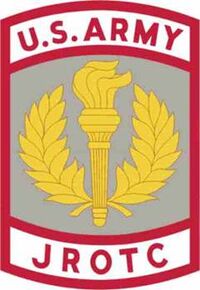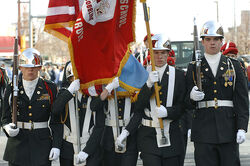The Army Junior Reserve Officers Training Corps, also known as AJROTC, is the largest Junior Reserve Officers Training Corps (JROTC) organization in the United States, with over 1,600 Units across the United States, its protectorates, and military bases around the World. It is also the largest of the JROTC programs.

Army JROTC emblem
History
Army JROTC traces its history back to the American Scientific, Literary, and Military Academy, later known as Norwich University, founded in 1819 by Captain Alden Partridge. Then, under the National Defense Acts of 1916, High Schools were allowed to have federal military equipment and instructors. This marks the birth of Junior Reserve Officer's Training Corps. Ever since then, Army JROTC has grown to include over 1,500 schools all across the United States and its territories. [1]
Program
Junior ROTC is an elective high school course taught by military personnel at selected private and public high schools in the United States and its territories. It is also taught abroad though the Department of Defense Dependents School System, which primarily serves the dependents of military personnel stationed overseas.
The curriculum, taught by retired military professionals, encompasses a broad spectrum of subjects, including:
- Communication Skills
- Leadership
- Physical Fitness
- First Aid, Drug Abuse Prevention
- History, Citizenship
- Technology Awareness
Junior ROTC awards academic grades, but its true measures of success are the young people it motivates to stay in school and graduate. It also develops the personal confidence and pride in self to avoid drugs and other negative peer pressures, and attain life skills that enhance success after graduation.

The Central High School Army Junior Reserve Officer Training Corps Color Guard marches during a parade in downtown Rapid City, S.D., Nov. 11, 2007. Rapid City hosted the parade to honor those who have served and are currently serving in the U.S. military. (U.S. Air Force photo by Staff Sgt. Michael B. Keller)
Established by Congress in 1916, Army Junior ROTC has demonstrated over the decades that it works. Junior ROTC Cadets generally graduate from high school at a higher rate than the school as a whole, and principals, parents, and former cadets consistently endorse the positive impact that Junior ROTC has had on the school, the community and the cadets themselves.
To motivate and develop young people is the goal of Junior ROTC. To accomplish this goal, it combines classroom instruction and extracurricular activities oriented on attaining an awareness of the rights, responsibilities, and privileges of citizenship; developing the student's (Cadet's) sense of personal responsibility; building life skills; and providing leadership opportunities.
Cadets are organized into units along military lines and are taught by retired military personnel, but Junior ROTC does not recruit students for military service. Instead, its focus is on developing young people and orienting them positively in preparation for whatever role in life they might choose. It is in this sense that Junior ROTC is part of the Army's service to the nation.[2]
A high school graduate that has completed two years of JROTC is eligible to enter recruit training as an E-2. A high school graduate with three years of JROTC is eligible to enter recruit training as an E-3.[3]
LET I
The mission of Leadership Education and Training (LET) is to motivate first year JROTC cadets to be better citizens. To accomplish this purpose, the text discusses citizenship, leadership, and a number of other courses designed to help the cadets succeed in high school and after graduation. Cadets wear uniforms one time each week. Extracurricular activities include: Providing color guards, eating at concession stands, participating in community parades, drill and rifle teams.
LET II
The second year of Leadership Education and Training provides more details about leadership situations. The program is split into units including: Techniques of Communication, Leadership, Cadet Challenge, Leadership Lab, First Aid, Map Reading, History, Your American Citizenship, Career Opportunities, and Role of the U.S. Army. The wearing of the uniform and extracurricular activities are the same as for LET I.[3]
LET III
The third year of Leadership Education and Training provides still more leadership situations. In this year students will not only be more involved as teacher and leaders within the cadet battalion, but they will also do more independent studies in the areas of communication, leader, first aid, history, map reading, career opportunities, and technology awareness. The wearing of the uniform and the extracurricular activities are the same as for LET I.[3]
LET IV
Fourth-year cadets are responsible for the daily cadet administration and perform as commanders and staff officers. They act as assistant instructors in some subject areas for other JROTC classes. They continue to develop their leadership skills and plan special unit events such as the military ball or the annual awards banquet.[3]
Structure
Army JROTC falls under the United States Army's Accessions Command, which is further under command of TRADOC. Branching from Accessions Command, there is Eastern Region, for all schools east of the Mississippi, and the Western Region, for all schools west of the Mississippi. [4]
Eastern Region
In the AJROTC Eastern Region, there are four brigades spanning across Maine, Vermont, New Hampshire, Massachutsetts, Conneticut, New Jersey, New York, Pennsylvania, Maryland, Ohio, West Virginia, Virginia, Kentucky, Tennesse, North Carolina, South Carolina, Georgia, Florida, Puerto Rico.[4]
Western Region
The Western Region contains eight brigades and spans across the western United States, Alaska, Hawaii, and the Pacific Islands. [4]
Cadet Insignia of Grade/Rank
Officers
The insignia for cadet officers consists of silver (white) color on black background, cloth epaulet sleeve with lozenges and discs. The sleeve is 4 inches in length for males and 3 inches in length for females. Cadets may wear disc insignia at the discretion of JROTC instructors.

Insignia of Grade/Shoulder Boards of Cadet Officers
- Cadet Colonel. The cadet colonel is identified by three lozenges.
- Cadet Lieutenant Colonel. The lieutenant colonel has two lozenges.
- Cadet Major. The cadet major has one lozenge.
- Cadet Captain. The cadet captain has three discs.
- Cadet First Lieutenant. The cadet first lieutenant has two discs.
- Cadet Second Lieutenant. The cadet second lieutenant has one disc.
These rank insignia are worn on both shoulder epaulets of the AG 344 and the Army Shade 415 gray-green shirt. When wearing rank disc insignia, the disc will be centered between the bottom of the button hole and the top of the shoulder seam of the garment.[5]
Enlisted
Insignia is of silver (white) color on black background, cloth shoulder epaulet sleeve with chevrons, bars, and diamond, star or star within wreath, indicating noncommissioned officer grades. The shoulder epaulet sleeve is 4 inches in length for males and 3 inches in length for females. Cadets may wear pin-on insignia of rank at the discretion of JROTC instructors.

Insignia of Grade/Shoulder Board of Cadet Enlisted
- Cadet Command Sergeant Major. Three chevrons above three bars with a star within a wreath between the chevrons and bars.
- Cadet Sergeant Major. Three chevrons above three bars with a star between the chevrons and bars.
- Cadet First Sergeant. Three chevrons above three bars with a diamond between the chevrons and bars.
- Cadet Master Sergeant. Three chevrons above three bars.
- Cadet Sergeant First Class. Three chevrons above two bars.
- Cadet Staff Sergeant. Three chevrons above one bar.
- Cadet Sergeant. Three chevrons.
- Cadet Corporal. Two chevrons.
- Cadet Private First Class. One chevron above one bar.
- Cadet Private. One chevron.
The shoulder epaulet sleeve is slipped over shoulder epaulet of uniform so that the insignia will be centered on the outer half of both shoulder loops of the coat, overcoat, or shirt when worn as an outer garment. When wearing rank disc insignia, the disc will be centered between the bottom of the button hole and the top of the shoulder seam of the garment.[5]
Sources
| ||||||||||||||||||||